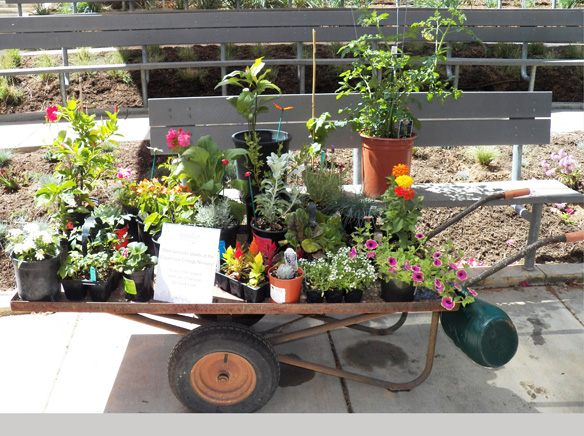The freshness of spring invites nature’s creatures to venture out, exploring and enjoying the landscape’s greenery and other possibilities for new growth. And springtime usually arrives early each year in locations around the Southwest. That was one major purpose for El Cajon’s Cuyamaca College as site of the 23rd annual Spring Garden Festival on April 23. The no-admission-charge celebration of Western outdoor life attracted an all-ages crowd. Varied events on the morning-through-afternoon schedule also brought in money to support college programs.
The freshness of spring invites nature’s creatures to venture out, exploring and enjoying the landscape’s greenery and other possibilities for new growth. And springtime usually arrives early each year in locations around the Southwest. That was one major purpose for El Cajon’s Cuyamaca College as site of the 23rd annual Spring Garden Festival on April 23. The no-admission-charge celebration of Western outdoor life attracted an all-ages crowd. Varied events on the morning-through-afternoon schedule also brought in money to support college programs.
Event organizers described the day’s activities as “celebrating California gardening 1994-2016.” The college’s Heritage of the Americas Museum opened its doors to visitors at no charge for festivalgoers. The museum’s watchword, emblazoned above the entrance, is “By their art shall we know them.” The museum’s wings display an impressive collection of art and cultural artifacts from throughout the Southwest and Central and South America.
The museum hosted docent-led tours during morning and afternoon hours, and offered a featured presentation of the day from Bill Evans, celebrating the 100th anniversary of the U.S. National Park Service and highlighting the variety of parks around the countryside. Evans titled his slideshow presentation “America’s Best Idea,” and he recounted throughout his talk personal anecdotes from his 20 years as a Sierra Club National Outings Leader. Evans described the National Parks Service as an extensive agency overseeing seashores, lakes, rivers, trails, monuments and historical sites, covering a land area the size of New Mexico and employing around 22,000 workers. The annual numbers of visitors to national parks is equal to the total U.S. population.
The college’s Water Conservation Garden, which surrounds the museum, had succulents for sale, tours of the garden and consultations regarding landscape design. On hand to discuss tips for saving water and reducing water bills were representatives of San Diego County water districts, including the local Helix Water District. Ongoing composting demonstrations were provided. Artists from the San Diego Watercolor Society painted scenes inspired by the garden.
The Cuyamaca College Nursery presented its largest plant sale of the year. This also happens to be East County’s biggest plant sale, and the focus was on native plants that ought to thrive even for local gardeners lacking a green thumb. Formal instructional sessions in the college’s Horticulture Building dealt with succulent plants, identification of good versus bad garden insects, and urban beekeeping.
Children had been asked to dress up in costume as a favorite insect, and the event provided a ladybug giveaway near the Grand Lawn area, at which adventuresome folk could capture the garden-friendly insects to take home. Musical background from a disc jockey entertained attendees at the Grand Lawn, where festivalgoers could purchase food and drinks while browsing the booths. Garden-themed art, books and kids activities were presented. One display booth offered advice on tree care and maintenance, which is especially problematic in balancing the objectives of saving water while preserving the health of trees as valuable natural resources in any garden.
The Heritage of the Americas Museum further put on a Five-Choices Dream Drawing for gamblers testing out their luck at $1 per ticket. The five different prizes to choose among came from the museum store and four wings of the museum. The Natural History Wing’s prize was a lovely amethyst cathedral from the gem and mineral show in Quartzsite, Arizona. From the Archaeology Wing, and donated by authenticator/appraiser Craig Helm, the choice was a framed collection of 63 paleo arrowheads dated at about 10,000 years old. Also donated by Helm and representing the Anthropology Wing was a set of artifacts including a Sioux dance wand from around 1900, adorned with a badger skull, buffalo horn, glass beads, rawhide shaft and horsehair tail. The Art Wing’s prize was an original butterfly and flowers painting by Diana Kam, entitled “Painted Ladies of the Flowers.” Kam engaged in painting another piece adjacent to the wing. Fifth and always popular during museum drawings, was the $50 gift certificate for purchases at the museum store. The raffles concluded with prizewinners drawn in the mid-afternoon.
Kathleen Oatsvall, the museum’s director, took a few moments away from the museum’s activities of the day to discuss the facility and its programs. She said, “Our mission is to educate.” She noted that entry to the museum is free for children 17 and under and for students. The Spring Garden Festival raffle’s income was set to go toward paying for programs and field trips for youth. Different curriculum-based field trips and outreach programs are geared toward students in second through sixth grades.
“We really have four world-class museums in one here,” Oatsvall continued, describing the museum’s Natural History, Archaeology, Anthropology and Art wings. The museum opened in 1993 as brainchild of founder Bernard “Bud” Lueck, who had envisioned the facility especially for children, for placing on display his vast collection of archaeological and cultural artifacts and artworks.
Oatsvall also wanted East County residents to become aware of the myriad of benefits from museum membership. Basic individual membership costs $20 yearly, offering free museum admission, a newsletter and advance notification of special events. The fee for student members and seniors 55 and older drops to $10 annually. Membership prices in the Heritage of the Americas Museum are “the absolute lowest,” among local museums. Oatsvall further pointed out the upcoming “Big Exchange” among area museums, held from May 1-18, during which a member of one museum will receive free general admission to 32 other museums around San Diego County, from the Oceanside Museum of Art to the Bonita Museum. Oatsvall ended by requesting interested people to consider volunteering at the museum, which confers VIP status to volunteers and their family members.
The Heritage of the Americas Museum is located at 12110 Cuyamaca Drive West. The museum is open Tuesdays through Fridays, 10 a.m. to 4 p.m., and Saturdays from noon until 4 p.m. More about the museum and its special events can be found by phoning (619) 670-5194 or online at www.cuyamaca.edu/museum. Additional information about the Spring Garden Festival is available at www.cuyamaca.edu/springfest.














